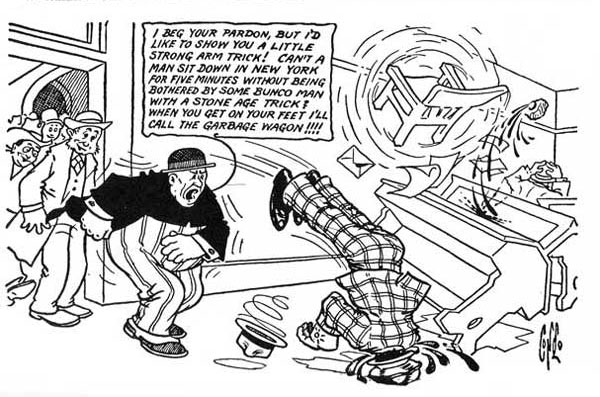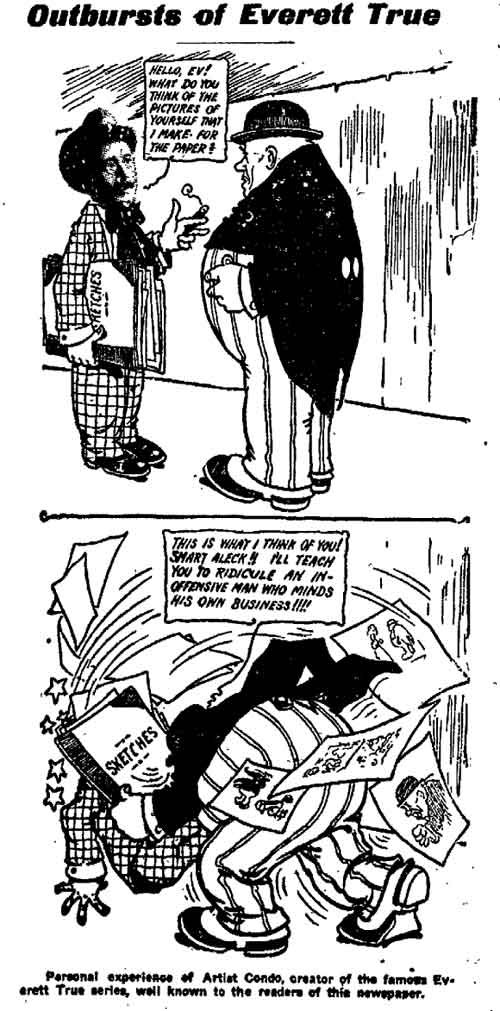'The Outbursts of Everett True'. 25 December 1906.
A.D. Condo was an American comic artist, best known for his gag-a-day newspaper comic 'The Outbursts of Everett True' (1905-1927). This short-tempered comic character entertained audiences for more than two decades with his rants and fights against anybody who annoyed him. Condo also holds historical importance for creating the first known science fiction comic: 'Mr. Skygack, From Mars' (1907-1912). While faded in obscurity today, Condo was once one of the most popular comic artists in the United States. His comics inspired a theatrical play, a silent comedy film and even the first instances of comics cosplay in history.
Early life and career
Armundo Dreisbach Condo was born in 1872 in Freeport, Illinois, as the son of a preacher who died in a cyclone when Armundo was only seven years old. In the late 1880s A.D. Condo worked as a printer's apprentice. In 1896 he became a cartoonist and caricaturist for the Toledo News-Bee, followed by the Cleveland Press and the Newspaper Enterprise Association.
The Outbursts of Everett True
At the Newspaper Enterprise Association, Condo created his signature weekday comic 'The Outbursts of Everett True' (1905-1927), in collaboration with J.W. Raper. It debuted on 22 July 1905 as 'A Chapter from the Life of Everett True'. Originally the comic was conceived as a gag series about a man who always told the truth, even if it wasn't socially acceptable. The eventual character, named Everett True, is not necessarily always right but still believes he is. The content of 'The Outbursts of Everett True' is as simple as its lay-out. Each episode consists of only two to three panels, one to introduce a situation which annoys Everett, the other to depict his furious reaction. Everett is the crankiest character ever. He is constantly irked by things like screaming babies, boring reverends, unhelpful store owners, cars nearly running him over, nosy and noisy people and especially preachy know-it-alls. Those who are lucky are only verbally insulted. Others are beat up too. The only person who dares to yell or fight back is his wife.
'The Outbursts of Everett True'. 7 October 1905.
Despite its formulaic set-up, 'Everett True' was a huge hit. Readers felt the everyday nuisances Everett went through were very recognizable. But while they held back he just spoke his mind. Everett was a hero to anyone who was easily irritated. He dared to voice his opinions and even get violent to get his point across. Nevertheless, Everett often comes across as a sociopathic bully. Most reactions are out-of-proportion. When a plumber gives him an expensive bill for fixing his bath, Everett throws him in the tub and starts strangling him under water. When a man offers him some life insurance, Everett just kicks him out of the window. In other episodes he even beats up people who merely ask him for help. Or people who just make the mistake of being around in his presence, like a young couple whose kissing annoys him.
Everett occasionally acts like a hypocrite. He snarls at people who have the nerve to talk to him, yet he hits a man who doesn't want to buy a paper from a newspaper boy with the words: "You want some humanity pounded into you". Everett also frequently beats up people who mistreat animals, but he too once threw a woman's dog out from a train, because: "If you have to drool over a dirty little pup why don't you do it some place where people won't hear you?" Other episodes are more an example of values dissonance. In one episode a woman refuses to give him her seat, whereupon he yells at her and suspects her of being "one of these activists for women's rights." In a 1917 gag, he beats up a man for being a conscientious objector, while not wanting to join the military for this reason is nevertheless a perfectly legal excuse. Regardless of these questionable actions, readers still sympathized with Everett, because he occasionally fought more noble causes too: thieves, voyeurs, gossipers, people who cut in front of lines... In a memorable 1917 gag, he even knocks out German emperor Wilhelm II for the sinking of the American cruiser Lusitania, which made the U.S. enter World War I.
'Everett True meets Kaiser Wilhelm', starring Wilhelm II of Germany.
Everett True: success and media adaptations
'The Outbursts of Everett True' was so popular that the character even received his own advice column, where he gave misanthropic answers to people's questions. In 1916, the comic was adapted into a live-action silent comedy film: 'Everett True Breaks Into the Movies' (1916). Condo seemingly never ran out of personal frustrations, because the comic ran for 22 years straight, with only a brief interruption in 1917-1918 when he was drafted for military service during World War I. Old episodes were frequently reprinted and published in compilation books. In addition, Clifton Meek created some strips titled 'Everett True and the True Triplets' in 1911 and ghosted some regular installments of 'The Outbursts of Everett True' for a couple of weeks from July 1912 on.
After Condo eventually quit the series in 1927 out of health reasons, 'Everett True' soon became forgotten for nearly half a century.
'The Outbursts of Everett True'.
Legacy of Everett True
Compared with many other early-20th century newspaper comics, 'Everett True' has proven to be remarkably timeless. Despite some dated references, most of Everett's irritations are as recognizable today as they were back then. Condo's sarcastic comedy hasn't aged either. Everett True can be considered the forefather of many grouchy comic and cartoon characters like Walt Disney's 'Donald Duck', Grumpy the dwarf, Peyo's 'Grouchy Smurf', Roberta Gregory's 'Bitchy Bitch' and Trey Parker and Matt Stone's Eric Cartman from 'South Park'. His persona is also similar to that of American comedian W.C. Fields, who was known to be a comics reader.
It therefore comes as no surprise that 'The Outbursts of Everett True' is still rediscovered today. In 1983, Everett even experienced an unexpected revival thanks to comic writer Tony Isabella, who republished and recollected many old episodes, which also ran again in the Comic Buyer's Guide and The Comics Journal. Near the end of the decade, the ancient character was so notable that in 1988 British music critic Jeremy Andrew Thackray chose 'Everett True' as his pseudonym. The circle was brought round when True collaborated with Peter Bagge to create a comic strip of his own, 'How to Write A Book About Nirvana' (1999), criticizing the posthumous exploitation of Kurt Cobain. Even today, several Internet users have created their own crude webcomics based on 'The Outbursts of Everett True'.
Mr. Skygack, From Mars
Condo also drew other comics. In October 1907, Condo created 'Mr. Skygack, From Mars' (1907-1917) for the Chicago Day Book, an advertisement-free tabloid which aimed at a working class audience. The series was soon picked up by several other local newspapers. The one-panel cartoon centers around a big-brained Martian who landed on Earth to study mankind. Just like Voltaire's short story 'Micromégas' (1752), much of its comedy revolves around the alien's frequent misunderstandings of human nature. For instance, he interprets a garbage bin as a food storage to prevent famine and assumes that people who shake hands want to pull each other limb from limb. In terms of comedy, 'Mr. Skygack' precedes humorous TV series like 'My Favorite Martian' (1963-1966, which also featured a Martian anthropologist.), 'Coneheads' (1977-1979), 'Mork and Mindy' (1978-1982), 'ALF' (1986-1990) and 'Third Rock From the Sun' (1996-2001) in its satirical observations of human society through the eyes of extraterrestrials. W. Aird MacDonald became the illustrator of 'Mr. Skygack, From Mars' in October 1912.
The comic lasted only as long as the Chicago Day Book itself. When the publication went bankrupt, Condo discontinued 'Mr. Skygack' too. While forgotten today, 'Mr. Skygack, From Mars' still holds historical significance for two reasons. Along with the comics of French artist G. Ri, 'Mr. Skygack' was one of the first known science fiction comics in history. 'Mr. Skygack' was also the first franchise to inspire someone to cosplay (making a costume to look like a fictional character). In 1908, a man named August Olson of Monroe, Washington, won the first prize at a masked ball by dressing up as Skygack. His wife had dressed herself up as another Condo character, Miss Dillpickles.
Oscar and Adolph
'Mr. Skygack, From Mars' also spawned a spin-off comic, centered around the side character Oscar. In the original series, Oscar was the obese nemesis of Skygack. He hates the Martian's bizarre appearance and nosy behavior. Condo teamed him up with a tall German waiter named Adolph in the spin-off, 'Oscar and Adolph' (1911-1915). The comedy consisted of slapstick situations in a restaurant, combined with ethnic comedy at the expense of German immigrants. Some of the episodes were ghosted by the artist Clifton Meek.
Diana Dillpickles
Around 1907, Condo drew 'Diana Dillpickles', which originated from an one-panel cartoon series in The Sacramento Star named 'Diana's Diary', scripted by F.W. Schaefer. Diana Dillpickles was a pretty but naïve blonde, whose stupidity was the source of many gags. Clifton Meek ghosted some episodes too.
Other comics
Other one-shot comics by Condo were 'The Country Man's Vacation in Town', 'Pity the Poor Farmer', 'Dainty Daisy Tries Physical Culture' (1906) and 'Enslaved By A Pirate'.
Death and legacy
A.D. Condo passed away in 1956. In a few 1969 episodes of V.T. Hamlin's comic strip 'Alley Oop' both Everett True, Oscar and Adolph make a cameo appearance.
Everett punching out his own author. 21 February 1907.
A.D. Condo at the Yesterday's Papers blog
A.D. Condo on Barnaclepress.com











